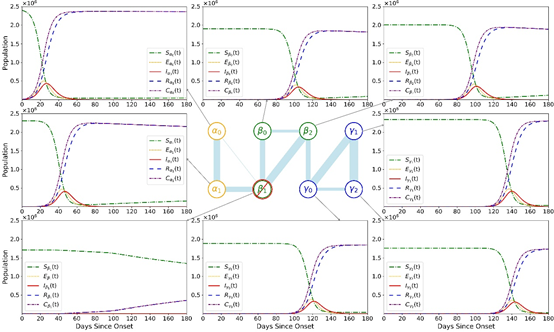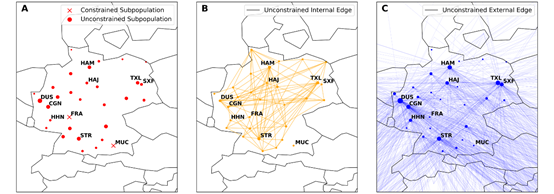Recently, Ding Yida, a sophomore from the School of General Engineering / International Research Institute for Multidisciplinary Science, Professor Sebastian Wandelt, and Associate Professor Sun Xiaoqian published an article titled “TLQP: Early-stage Transportation Lock-down and Quarantine Problem” in Transportation Research Part C: Emerging Technologies, a well-known international journal in the field of transportation systems and emerging technologies (impact factor: 6.077). Against the Background of COVID-19 pandemic and based on the global air traffic network and the disease spread model, the authors analyze the anti-pandemic strategies that are effective to contain the spread of COVID-19 with low socio-economic costs.
The current transportation system with high intensity and massive traffic flow, especially the air traffic network, has significantly contributed to the risk of spreading diseases worldwide. Except for keeping social distance and wearing face masks, restrictions on people’s movements, such as transportation lock-down and quarantine, are necessary to prevent the spread of COVID-19. Considering the socio-economic costs of anti-pandemic measures, the authors model the related decisions on the lock-down/reduction of movement as a combinatorial optimization problem. The paper proposes the Early-stage Transportation Lock-down and Quarantine Problem (TLQP), which can help decision-makers to decide which parts of the transportation infrastructure of a country should be restricted in early stages.
Based on the network-based Susceptible-Exposed-Infectious-Recovered (SEIR) model, the authors establish a decision recommendation framework, which considers the lock-down of cross-border traffic, internal traffic, and movement inside individual populations. In light of the high complexity of the combinatorial optimization problem, one effective and reliable heuristic algorithm TLQP-H, which is based on the Effective Distance (ED) path and the Cost-Effective Lazy Forward (CELF) algorithm, is put forward in the paper. The researchers also report the experimental results of the solution techniques and applies them to the decision making of Germany in face of the first and second waves of global pandemic, providing policy-makers with instructive advice on pandemic prevention.

Fig. 1 The spatial structure of an epidemic network and the SEIR models of each vertex.

Fig. 2 The spatial structures of ED tree for the pandemic spread network. The width of the edges is proportionally correlated to the magnitude of flow, while the length (effective distance) is negativelycorrelated with the flow.

Fig. 3 The situation of constrained/unconstrained subpopulations, unconstrained internal transportation edges and external transportation edges during the first wave of global pandemic, generated by TLQP-H.
Sun Xiaoqian, Associate Professor from the School of General Engineering / International Research Institute for Multidisciplinary Science, is the only corresponding author of the paper. She has been selected into the “Zhuoyue” Program and the "Youth Top-notch Talent Support Program" of Beihang University. She is also the Theodore von Karman Fellow of RWTH Aachen University and the Fellow of TU Dresden. She is mainly engaged in the research of air traffic networks, multimodal integrated transportation system, and intelligent optimization algorithms for large-scale systems. The research was supported by the Research Fund from the National Natural Science Foundation of China.
The link to the article is:
https://www.sciencedirect.com/science/article/pii/S0968090X21002321
Written by Sun Xiaoqian
Reviewed by Wen Dongsheng
Edited by Jia Aiping
Translated by Li Xueru

